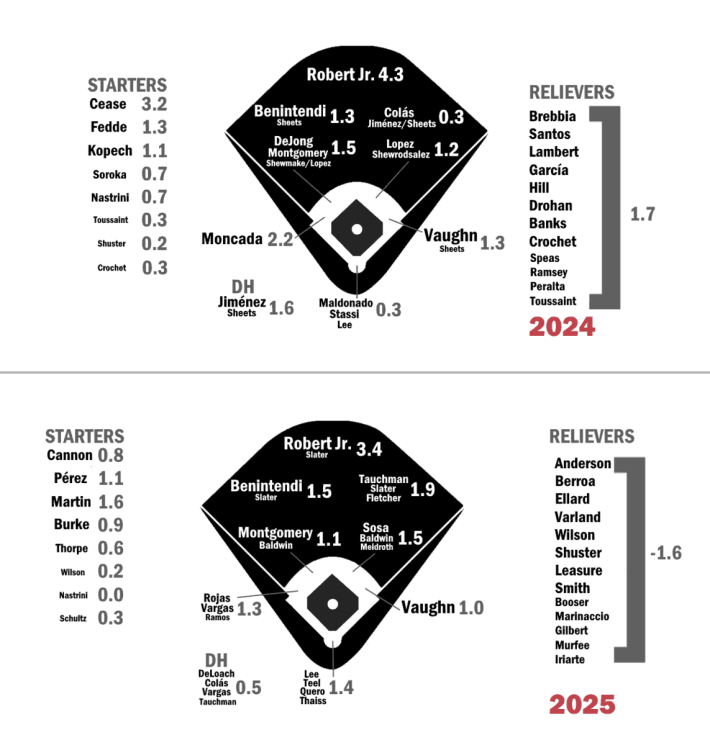Dan Szymborski's ZiPS projections for the 2025 White Sox lay bare the tension between Chris Getz's private and public-facing responsibilities. He sounds satisfied with the progress he's making in updating the organization's blighted infrastructure, but the on-field product by which he is measured reflects no particular acumen for the job. Literally anybody can build a team that loses the most games in modern MLB history because "never show up to work" would be the shortest distance between two points. Getz actually tried to imprint an identity upon the team, which kinda makes it worse?
Anyway, the thorough nature of the collapse that sent the Sox plummeting to 121 losses, followed by Getz's steady stream of unimpressive transactions this winter, means that the 2025 projections don't appear to be any less unkind.
Szymborski posted the White Sox ZiPS projections at FanGraphs on Monday -- and then he joined Josh on this morning's Sox Machine Podcast -- and in both cases, he expressed astonishment by what the Sox made the system spit out:
I’m fairly confident the White Sox will win more games this year than last, and ZiPS projects a 20-win improvement, which would be quite impressive for most teams.
But is that a good thing? Looking at the lineup as it currently stands, I’m not quite so sure.
If you're only looking at the organization's talent as a forest and aren't particularly invested in the storylines of trees, the White Sox haven't done anything to warrant a closer look. Luis Robert Jr. is the roster's only good position player, and he's coming off the worst performance of his professional career. On the pitching side, Szymborski relays that ZiPS projected zero league-average ERAs in the group. He can't recall seeing that from another team, because usually someone manages to reach a 100 ERA+, even if it's a small-sample mirage.
The best thing that can be said about the 2025 roster as a unit is that the rotation is filled with young pitchers who deserve starts (and Martín Perez). They just haven't put forth any kind of sustained success at the upper levels that makes them project beyond back-end reinforcement.
It's remarkable that there's so little to say that's positive about these projections, and yet they're pegged for a 20-win improvement. The burial of standards is what makes such a leap dangerous. Just like the human body can adjust to heaping helpings of environmental pollutants at the expense of long-term quality of life, there's a risk of seeing a 100-loss season as an accomplishment, rather than recognizing it as an extension of a string of colossal failures.
The win total won't distinguish the season from the ones that came before, unless it starts with a "3." Instead, a successful White Sox season will hinge more on developments that feel substantial and repeatable, because they'll need to be repeated two or three more times in order to stand a chance of supplementing a winning roster. Here are a few that stand out to me.
No. 1: One (or more) of the White Sox's back-end starters elevating to mid-rotation next year.
If there is indeed a Brian Bannister effect, the product should show up this season. James just relayed how Jonathan Cannon is preparing to build off a decent rookie season, just like there's reason to believe that Davis Martin can put his Tommy John surgery entirely behind him, or that the bone spur was the only thing holding Drew Thorpe back, or that Sean Burke's surprising September reflects the physical gifts that made him a third-round pick despite the control concerns. Further downstream are guys like Ky Bush and Jairo Iriarte, both of whom have shown enough to warrant further big-league looks in due time.
From this handful of pitchers, it's not unreasonable that one could develop into a sturdy No. 3 starter, and another looks no worse than No. 4. Even the best teams require a healthy supply of such pitchers, and the White Sox would be close to having what they need here, at least assuming Noah Schultz and Hagen Smith progress as planned.
No. 2: Better right field and/or second base production.
Focusing on the contributions of journeymen doesn't rate as a priority, and thanks to Paul DeJong, we just saw how little the White Sox gain from having one carry the offense. That said, it stood out to me that right field and second base -- two perennially underwater positions -- have benefited from Getz's offseason activity when comparing 2024's projections to 2025's.

This mix features novel concepts like complementary platoon players, outfielders playing in the outfield, and younger players with Triple-A success and potentially unrealized upside getting shots to succeed. There's a reason why Mike Tauchman and Austin Slater cost less than $2 million each, and why Chase Meidroth was the third player in the return for Garrett Crochet. But after years of setting up a lineage of limited players for failure, it'd be nice for the White Sox to see the benefits of putting them in a position to succeed, even if the names are likely to change next season. Getting average production from a given position once per decade shouldn't be as hard as the White Sox make it look.
No. 3: Colson Montgomery being somebody.
The scariest ZiPS projections are right next to each other:
- Player A: .204/.298/.327, 77 OPS+, 0.8 WAR
- Player B: .218/.287/.328, 73 OPS+, 0.8 WAR
The subhead lets you know that one of these players is Colson Montgomery. He's Player A. Player B is Jake Amaya, whom the White Sox just designated for assignment in order to make room for Josh Rojas. One shouldn't resemble the other.
Shortstop is the most incongruous situation on the depth chart. Everywhere else, you can see how Getz is attempting to share burdens and limit liabilities, even if you're not impressed by the efforts. Pérez takes stress off the aforementioned fringe arms, Tauchman and Slater look like platoon partners, Rojas can spell the right-handed hitters at third and second, and Matt Thaiss is there to keep Kyle Teel and Edgar Quero cooking in Triple-A. Meanwhile, shortstop features a Brooks Baldwin who still has his rookie eligibility due to a wrist issue, and a Montgomery who is coming off one of those character-building seasons for which nobody asks.
There's reason to think that either player could be successful in time, but neither enters 2025 in a position of strength. Baldwin was thrust into MLB action after just eight games at Triple-A, and had trouble treading water. Montgomery was able to end a trying season on a high note with a late-season uptick in Uptown Charlotte and a strong performance in the Arizona Fall League, but he still has to show that he has more than one swing.
Montgomery's flaws are pronounced enough to make contingency plans a little too necessary, but the void he leaves in the ZiPS projections show why some measure of success is still critical to the White Sox's foreseeable future. In a system that's still light on bats, the immediate future looks far more dismal if he can't be told apart from a post-hype waiver claim. They'd invite far less second-guessing if they required Montgomery to earn the job, rather than being awarded a partial share or more by default.
There's enough winter remaining that the White Sox could insulate shortstop like they have the other positions. Enough winter has also passed to make it possible that the White Sox are giving Montgomery every chance to win the job at the outset of the season, with Getz's public comments tilting toward the latter. That course would either indicate a supreme amount of possibly warranted confidence in Montgomery's late-season improvements, or a shocking amount of unearned confidence in their ability to develop players on the fly.






